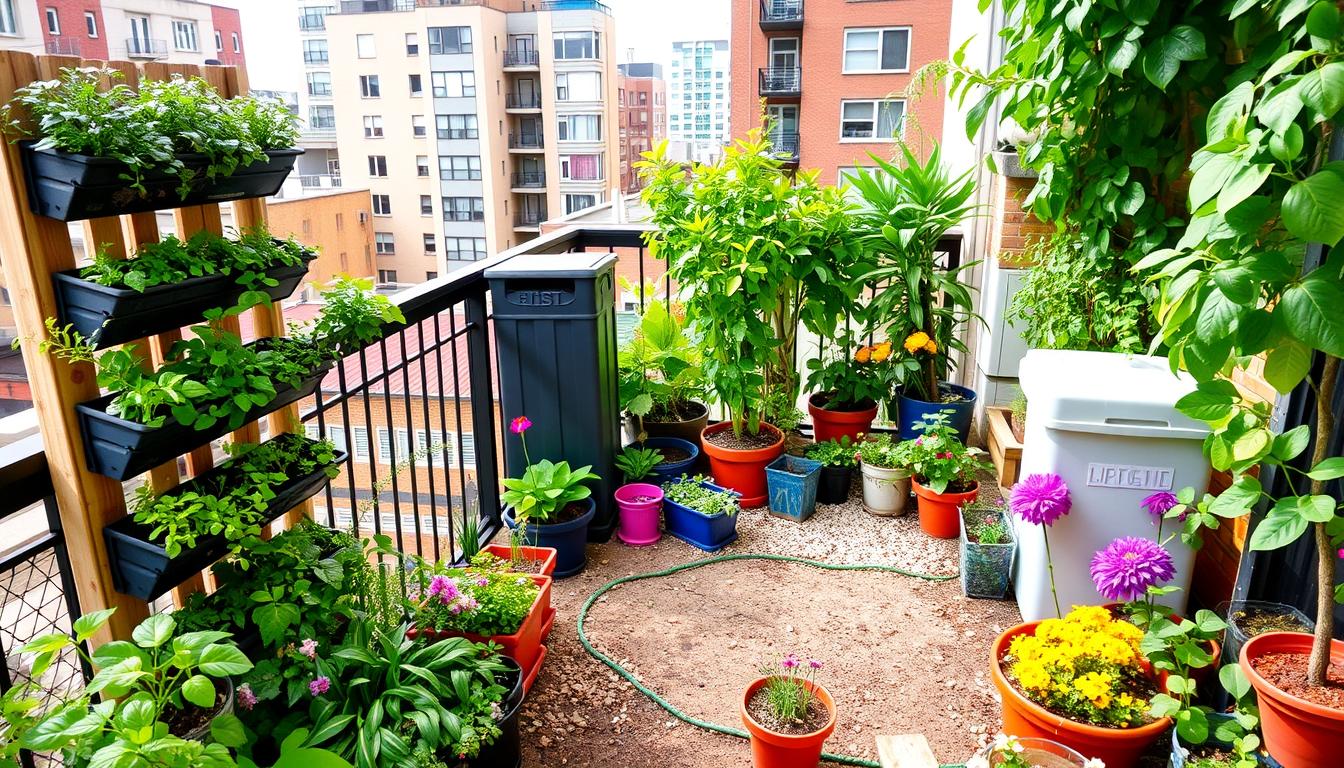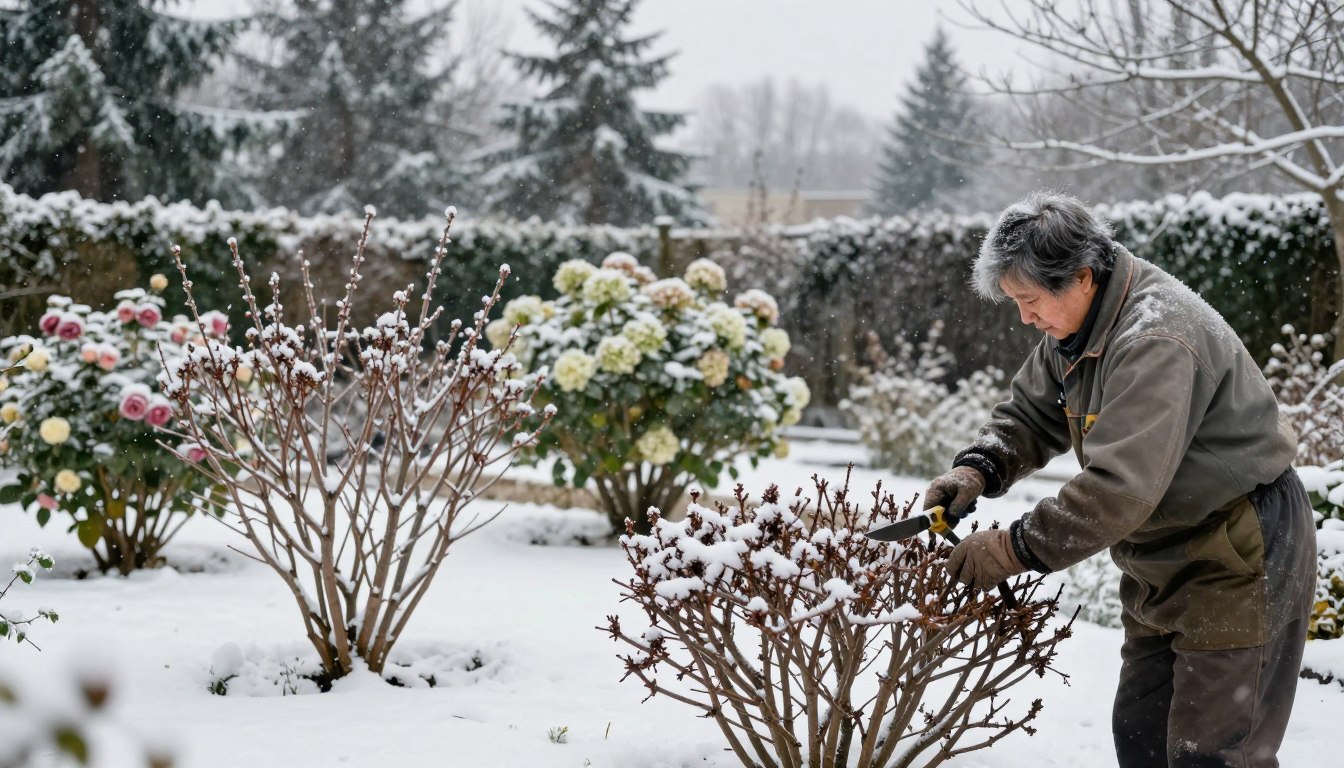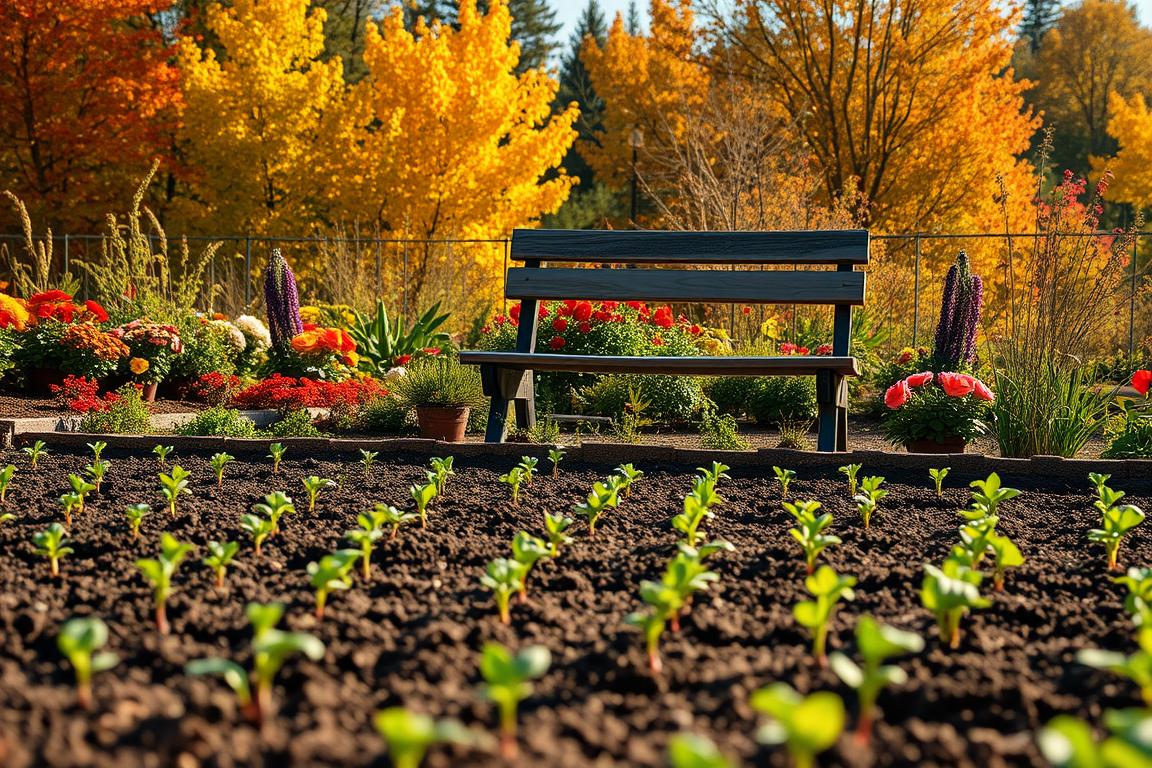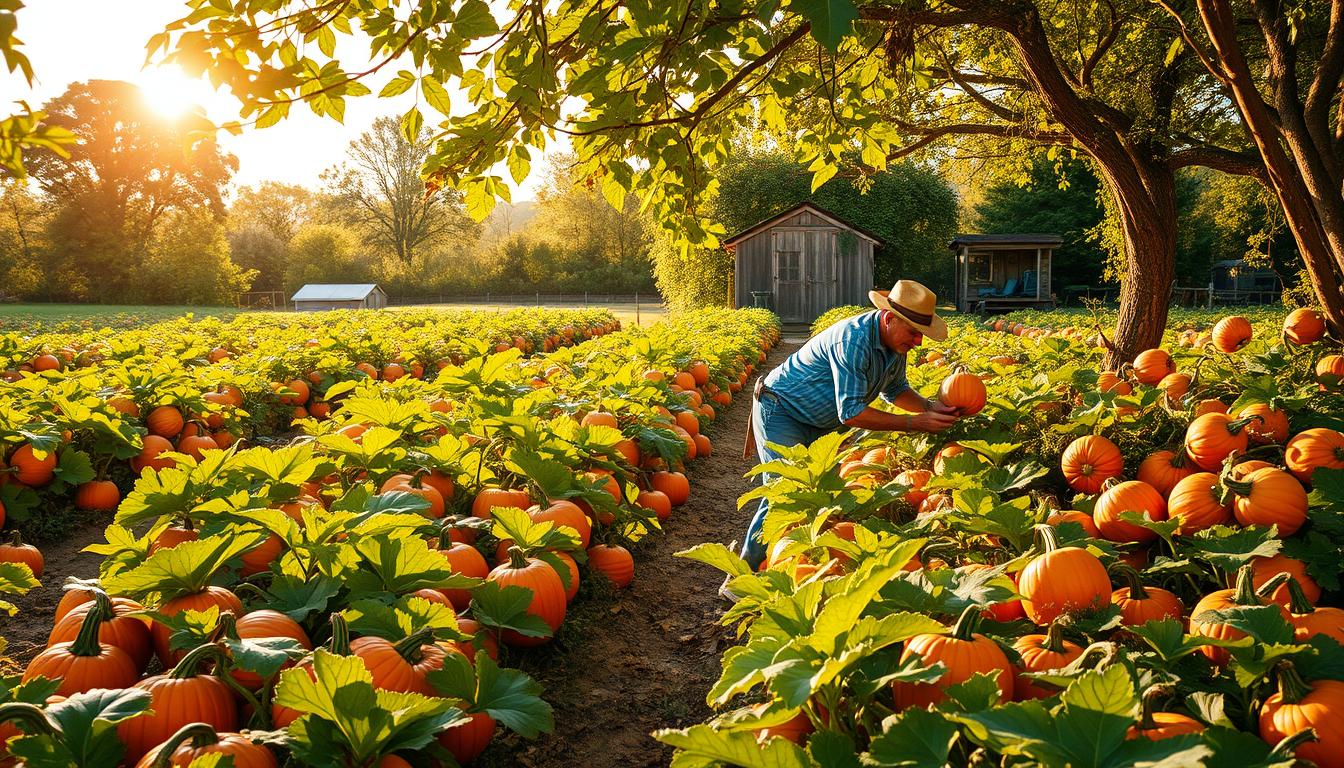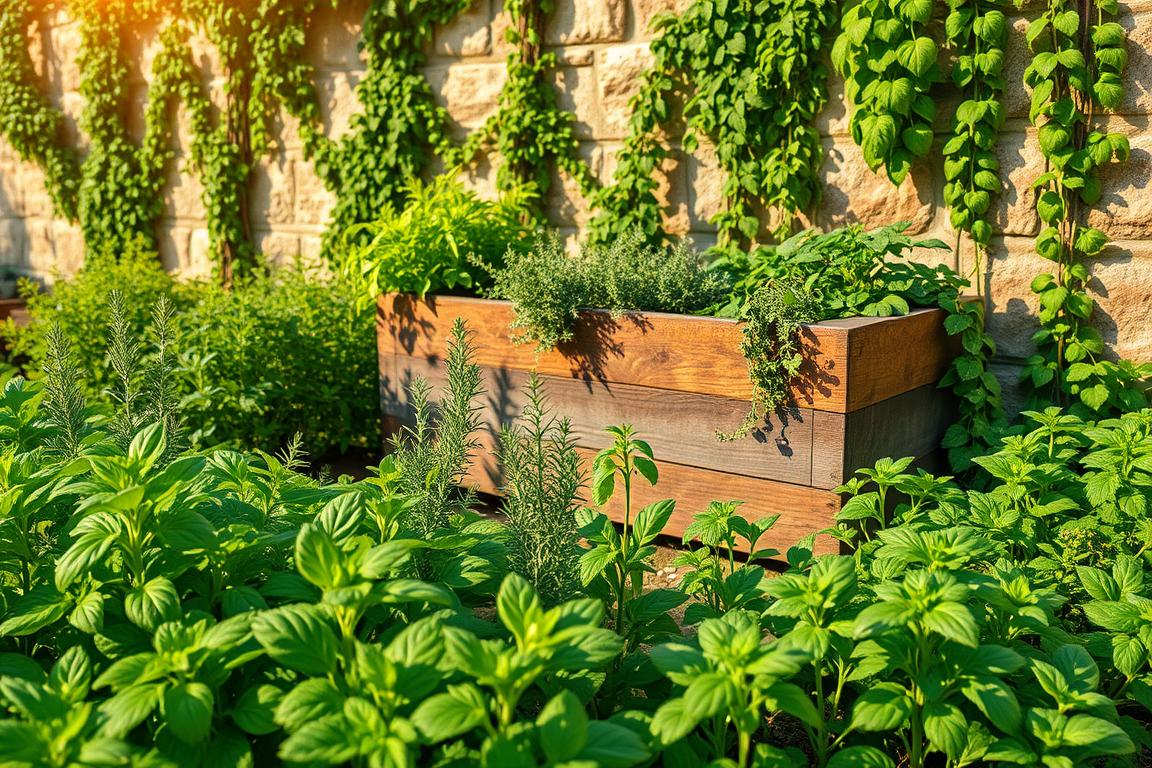As an urban homesteader, I’ve found that you can homestead in small spaces. It’s all about using smart techniques and strategies. You can grow your own food and live sustainably, even in tiny areas.
Harold Thornbro shows us it’s possible. He homesteads on just 1/10 of an acre but has a big garden. He uses permaculture to grow a lot of food, proving you don’t need a lot of land. By composting and using vertical gardening, you can make your urban space productive.
Key Takeaways
- Homesteading in small spaces is possible with the right techniques and strategies
- Urban homesteading allows for self-sufficient lifestyle and food production
- Small space gardening can be maximized with vertical gardening and composting
- Compact homesteading environments can be perfect for apartment homesteading or small backyard gardens
- Sustainable living in small spaces is achievable through urban homesteading practices
Getting Started with Homesteading in Small Spaces
Starting my journey in sustainable living in small spaces is exciting. I first assess my space and learn about urban zoning laws. Homesteading in small spaces needs careful planning for success. With 40% of Americans in cities, urban homesteading offers great opportunities.
It’s key to evaluate your space and set achievable goals. Check how much sunlight your area gets. Most plants need at least 6 hours of direct sunlight. Use vertical gardening to make the most of your space. Here are some tips for homesteading in small areas:
- Start small and grow your garden or urban homestead gradually
- Use container gardening and hanging baskets for more vertical space
- Choose compact or dwarf plant varieties to save space
- Implement succession planting for better yield and soil health
By following these tips and adopting sustainable practices, you can have a thriving urban homestead. Always check your local zoning laws before starting.
With patience, dedication, and the right strategies, you can achieve self-sufficiency in small spaces. Enjoy the benefits of city homesteading.
| Space Requirement | Plant Variety | Yield |
|---|---|---|
| Small | Compact Tomatoes | 10-15 fruits |
| Medium | Dwarf Citrus | 5-10 fruits |
| Large | Full-size Vegetables | 20-30 fruits |
Essential Tools and Equipment for Urban Homesteading
As I explore urban homesteading, I’ve found that the right tools are key for small space self-sufficiency. From containers and trellises to irrigation systems, each item is important for maximizing space for homesteading. For homesteading tips for limited space, it’s smart to choose versatile, space-saving gear.
Some essential tools for urban homesteading include:
- Cast iron skillets for cooking
- Water bath canners for preserving food
- Digital readout thermometers for precise cooking
- Broadforks for gardening
For those with small space livestock, tools like chicken coops and rabbit hutches are vital. With the right tools and equipment, urban homesteaders can thrive in small spaces.
By using these homesteading tips for limited space and the right gear, anyone can achieve small space self-sufficiency. This way, they can enjoy the perks of urban homesteading.
| Tool | Price | Description |
|---|---|---|
| Cast iron skillet | $18.99 | Essential for cooking |
| Water bath canner | $49.99 | For preserving food |
| Digital readout thermometer | Varies | For precise cooking |
Vertical Gardening Solutions for Limited Spaces
Exploring ways to make the most of space for homesteading, I found vertical gardening’s amazing benefits. It lets us grow plants on walls, windows, and ceilings. This makes small spaces very productive and efficient.
Vertical gardening greatly increases planting space. Wall-mounted systems, hanging gardens, and containers help grow plants in tiny areas. This is perfect for small space farming, where every inch matters.
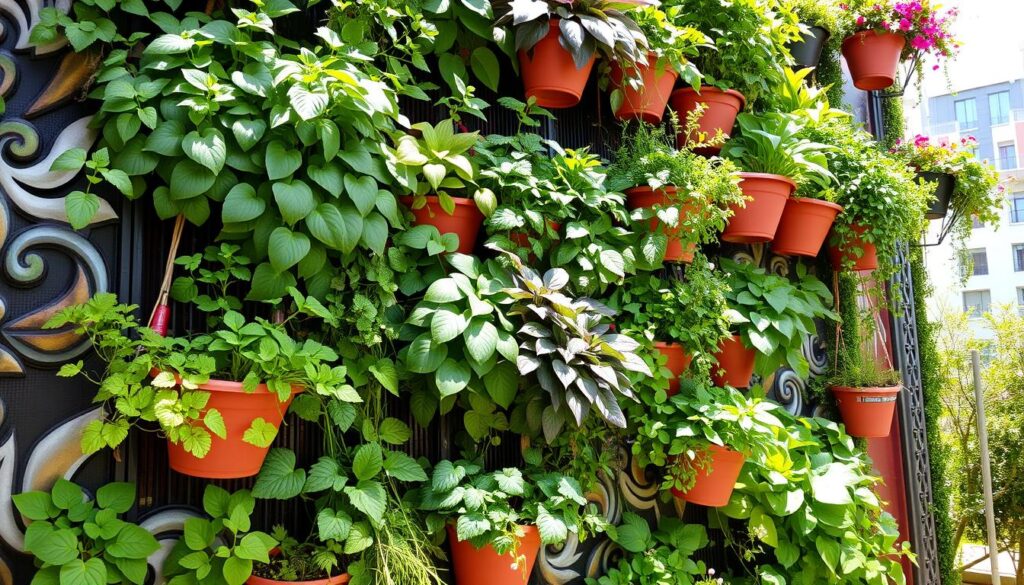
Effective small space homesteading tips include using trellises and cattle panels for vining plants. You can also grow herbs and leafy greens in window spaces. These strategies help create a productive garden in limited spaces.
Wall-Mounted Growing Systems
Wall-mounted growing systems are great for maximizing space. They can be tailored to fit your needs and support many types of plants.
Hanging Gardens and Containers
Hanging gardens and containers are excellent for small spaces. They’re perfect for growing tomatoes, peppers, and herbs. Plus, they can be moved to get the best sunlight and soil.
Utilizing Window Spaces
Window spaces are great for growing herbs, leafy greens, and flowers. They help create a beautiful and productive garden in small areas.
Container Gardening Fundamentals
Exploring small space farming, I’ve learned how vital container gardening is. It lets you grow fresh produce, herbs, and flowers in tight spots like balconies or sunny windows. This makes it perfect for those with little space.
Choosing the right containers is key. Tomatoes need at least 10-gallon pots to grow well. Eggplants do best in 10-gallon pots too. Compact varieties of broccoli, like Rapini, can grow in smaller pots. They give you shoots for about a month.
Lettuce, peppers, and strawberries are great for container gardening. They’re ideal for small spaces and support sustainable living. Using vertical gardening, like trellises and hanging planters, boosts your yield.
Container gardening has many benefits:
- It lets you grow fresh produce in small areas.
- It’s great for small space farming and homesteading.
- You can grow many types of crops, including fruits, veggies, and herbs.
- It supports sustainable living and self-sufficiency in small spaces.
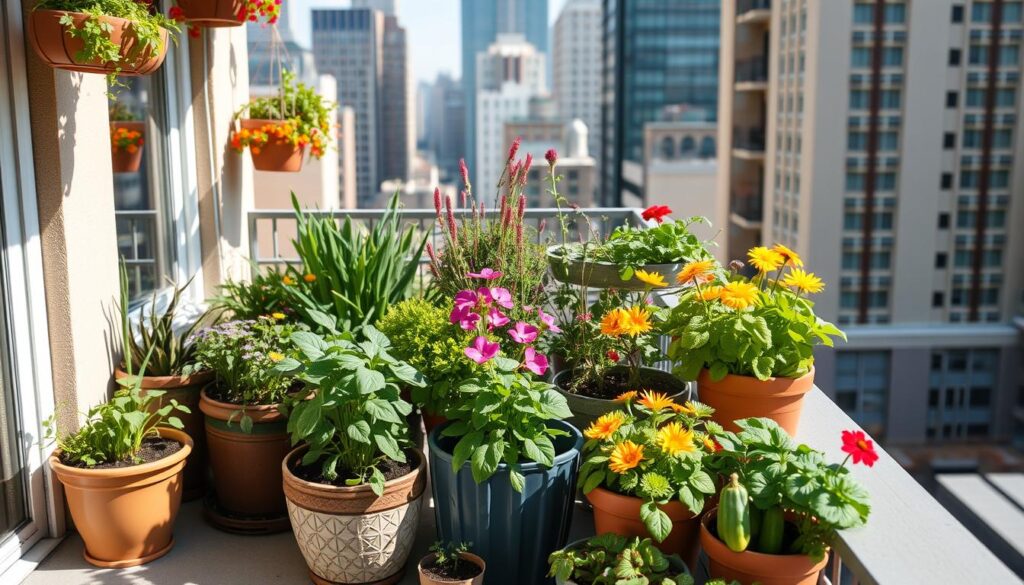
By mastering container gardening, you can make a thriving garden in tiny spaces. Enjoy the perks of small space farming, homesteading, and sustainable living.
| Plant | Container Size | Notes |
|---|---|---|
| Tomatoes | 10 gallons | Requires full sun and well-draining soil |
| Eggplants | 10 gallons | Prefers warm weather and consistent moisture |
| Broccoli | 5 gallons | Compact varieties available for small spaces |
Maximizing Growing Space with Smart Planning
Urban farming shows that growing food in small spaces is not just possible but also rewarding. Micro homesteading lets people grow gardens in tiny areas. It’s all about smart planning, like using companion planting, succession planting, and space-saving layouts.
Companion planting is key to using space well. It means pairing plants that help each other grow and fight pests. For instance, marigolds with tomatoes keep nematodes away, and basil and mint make nearby plants taste better. These homesteading tips help build a strong and diverse garden.
Companion Planting Strategies
- Planting marigolds with tomatoes to deter nematodes
- Pairing basil and mint to improve flavor and fragrance
- Using nasturtiums to repel aphids and whiteflies
Succession planting is also vital. It means planting seeds often to keep a steady harvest. This way, you can grow a lot of food in a little space. It’s a great way to enjoy fresh produce all the time, even in small areas.
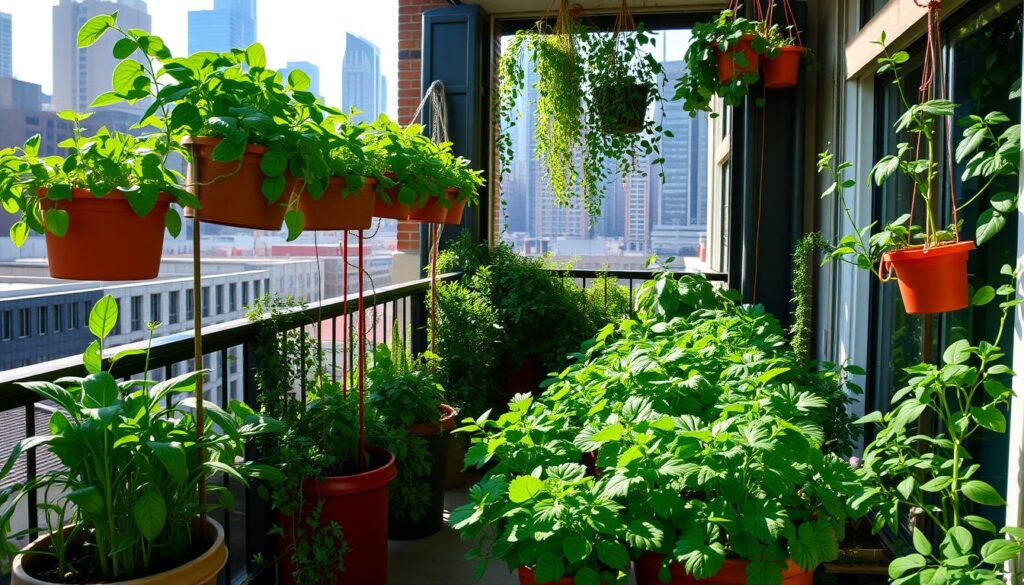
Space-Saving Garden Layouts
Using space-saving layouts like vertical and container gardening is smart. These methods pack a lot of plants into a small area. They help create a productive and green space, even in the city.
| Plant | Companion Plant | Benefits |
|---|---|---|
| Tomatoes | Marigolds | Deters nematodes |
| Basil | Mint | Improves flavor and fragrance |
| Nasturtiums | Aphids and whiteflies | Repels pests |
Indoor Growing Systems and Microgreens
As a homesteader in a small space, I’ve found indoor growing systems and microgreens to be great. They let me grow food all year, even in a small area. Microgreens are perfect for small space homesteading because they’re ready to eat in just 7-10 days.
Some homesteading tips for growing microgreens include using a 2-foot T5 fluorescent fixture. Also, keep the seeds in contact with the soil using weights or stacking trays. Here are more homesteading tips for small areas:
- Use a bottom watering system to ensure adequate moisture without over-saturation
- Provide at least 14 hours of light per day for proper growth post-germination
- Harvest microgreens before they become tough or woody, typically within 7-10 days of planting
By following these tips and using indoor growing systems, I can create a sustainable food source. With the right homesteading ideas and equipment, anyone can grow their own microgreens. This way, they can enjoy fresh, nutritious produce.
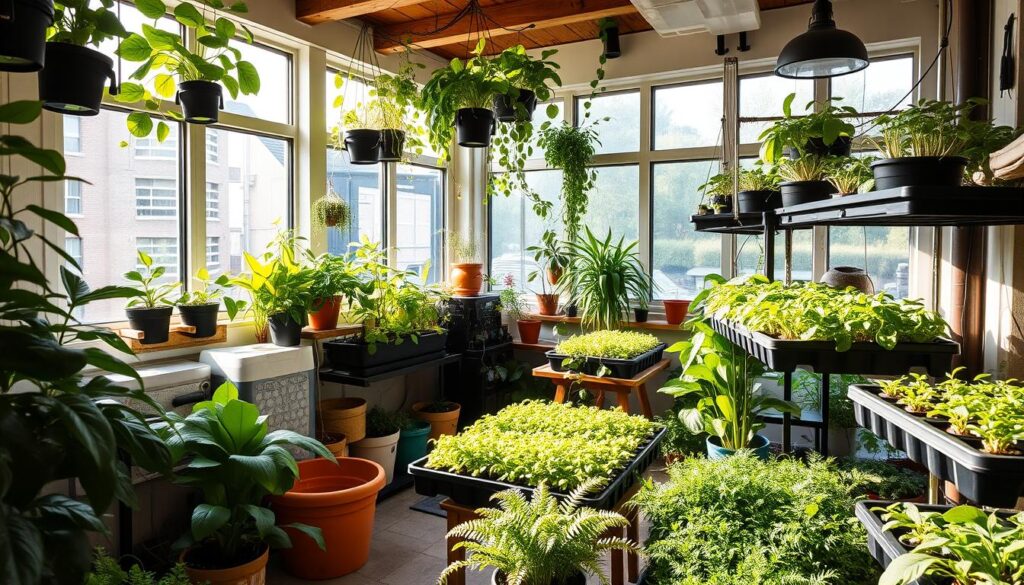
| Microgreen | Harvest Time | Nutrient Density |
|---|---|---|
| Red Cabbage | 7-10 days | 40 times more vitamin E and 6 times more vitamin C than fully-grown red cabbage |
| Peas | 7-10 days | Higher nutrient density compared to their full-grown counterparts |
Small Space Composting Methods
Exploring homesteading tips for small areas shows the need for sustainable living. Composting is key, but it can be tough in tiny lots. The right methods make it easier to use small spaces for homesteading.
Composting is vital for urban homesteading. Small space composting methods help create a sustainable lifestyle. Some popular methods include:
- Bokashi composting: allows for the composting of various materials, including meat and dairy, and requires about 10 to 12 days for the initial fermentation.
- Vermicomposting: uses worms to break down food scraps, producing a highly efficient composting method for small spaces.
- Counter-top solutions: provide a convenient and space-saving way to compost, perfect for homesteading on a tiny lot.
These small space composting methods help reduce waste and create nutrient-rich soil. It’s good for the environment and promotes self-sufficiency.
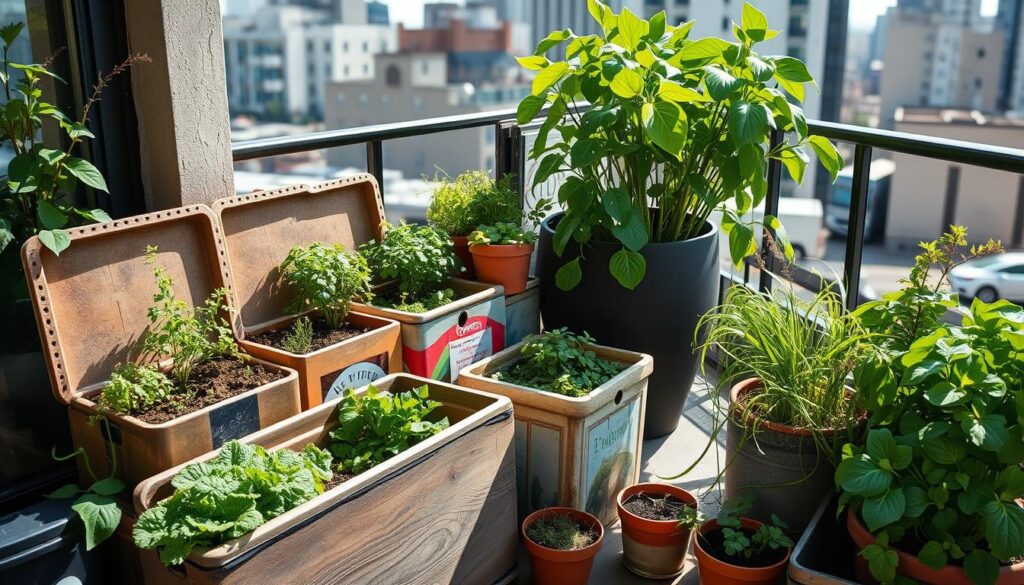
With the right tools and knowledge, anyone can compost in a small space. It makes a big difference for the environment and community. These homesteading tips help us build a more sustainable future.
| Composting Method | Space Requirement | Efficiency |
|---|---|---|
| Bokashi Composting | Small | High |
| Vermicomposting | Minimal | Very High |
| Counter-top Solutions | Compact | Medium |
Urban Livestock Options
Urban livestock options are perfect for maximizing small spaces for homesteading. You can raise animals like chickens, bees, and rabbits in a mini homestead. These animals give you fresh eggs, honey, and meat, adding value to your urban homestead.
Some popular urban livestock options include:
- Chickens: great for eggs and meat, and can be kept in small spaces
- Bees: provide honey and can be kept in a small apiary
- Rabbits: can be raised for meat and are a quieter alternative to chickens
Adding these urban livestock options to your self-sufficiency in limited space plan is smart. They can thrive in small spaces with the right care. This makes them ideal for starting a mini homestead.
Here is a table summarizing some of the benefits of urban livestock options:
| Animal | Benefits |
|---|---|
| Chickens | Fresh eggs, meat, and fertilizer |
| Bees | Honey, wax, and pollination |
| Rabbits | Meat, fertilizer, and quiet alternative to chickens |
Water Management and Conservation
As a mini homestead owner, I know how vital water management and conservation are. In the U.S., 50% of communities face water scarcity. This makes efficient methods like drip irrigation systems key. They can cut water use by up to 50% compared to overhead watering.
In tiny homesteading, saving water is a must. Practices like rainwater harvesting can lower water bills. Collecting rainwater reduces our need for municipal water. Also, using grey water can save 50-60 gallons of water daily for most homes.
- Xeriscaping can cut outdoor water use by 30% to 50%.
- Switching to drought-resistant plants can save about 1,000 gallons of water yearly.
- Mulching garden beds can lower soil moisture loss by up to 70%.
By using these sustainable practices, we can live more self-sufficiently and lessen our impact on the environment. As we dive deeper into mini and tiny homesteading, focusing on water management and conservation is critical. It helps our urban homesteads thrive.
Year-Round Growing Techniques
Exploring urban homesteading, I learned about growing food all year. This way, I can get fresh produce from my small garden, even in winter. Vertical gardening helps me use space well and grow more food.
Using cold frames, greenhouses, and indoor systems helps me grow food longer. For instance, I can grow lettuce in spring and fall. This way, I always have fresh lettuce. These methods make my garden productive all year.
Here are some benefits of growing food year-round:
- Extended growing season
- Increased crop production
- Fresh produce all year round
These techniques help me grow more food and rely less on outside sources. You can use them in any small space. This way, you can enjoy the benefits of growing your own food.
Preserving and Storing Your Harvest
Exploring small space homesteading shows how vital preserving and storing harvests is. In limited spaces, careful planning is key. Balcony farming is a great way to grow food, even in small areas.
There are many ways to preserve and store your harvest. Canning, freezing, and dehydrating are popular choices. These methods let you enjoy your food all year, reduce waste, and save money. Here are some tips:
- Canning: This method seals food in jars to keep it fresh. It’s perfect for fruits, veggies, and sauces.
- Freezing: Freezing is easy and keeps many types of produce fresh. Just blanch and freeze in airtight containers or bags.
- Dehydrating: This method removes water from food, making it light and easy to store. You can use a dehydrator or dry food in the sun.
Using these methods, you can have a steady food supply, even in tiny spaces. Always follow safe food preservation practices to keep your food safe.
Efficient homesteading in small spaces also means using vertical gardening. This includes wall-mounted systems or hanging gardens. These methods help you grow more food, even on a small balcony or patio.
| Preservation Method | Description |
|---|---|
| Canning | Sealing food in airtight jars to preserve it |
| Freezing | Freezing produce to preserve it |
| Dehydrating | Removing water content from produce to preserve it |
Conclusion: Building Your Urban Homestead One Step at a Time
Looking back, I see that turning small areas into gardens is both achievable and fulfilling. Balcony farming and apartment gardening let even tiny spaces grow fresh food. Using vertical gardening and indoor farming boosts yields, helping us move towards urban self-sufficiency.
About 35% of city folks garden, showing a rise in self-sufficiency. By using small space homesteading ideas and planning well, we can grow more and sustain our efforts. Anyone can start a successful urban homestead, step by step.
Investing in smart systems and connecting with other homesteaders cuts costs and boosts efficiency. As I keep exploring urban homesteading, I’m eager to learn more. I’m sure I can make a sustainable, thriving homestead. I hope to encourage others to do the same.
FAQ
What is homesteading in small spaces and how can I get started?
Homesteading in small spaces means growing your own food and collecting water in a small area. This could be a backyard or balcony. First, check how much space you have. Then, learn about local zoning laws. Lastly, set goals for your project.
What are the essential tools and equipment needed for urban homesteading?
You’ll need containers, trellises, and irrigation systems for urban homesteading. These help you use your space well. Also, get good soil, seeds, and gardening gloves.
How can I maximize my growing space using vertical gardening solutions?
Use wall-mounted systems, hanging gardens, and containers to grow more plants. These solutions work even in tiny spaces. Use windows and trellises to grow more.
What are the fundamentals of container gardening and how can I get started?
For container gardening, pick the right containers, soil, and plants. Choose containers that are 5-7 gallons with drainage holes. Use quality potting soil and plants like herbs and veggies.
How can I maximize my growing space using smart planning strategies?
Use companion planting, succession planting, and space-saving layouts. Companion planting helps plants grow better together. Succession planting gives you a steady harvest. Use trellises and supports to save space.
What are indoor growing systems and microgreens, and how can I use them in my homesteading project?
Indoor growing systems and microgreens are great for small spaces. They work indoors, even in winter. Microgreens are young, nutritious greens for salads and more.
How can I compost in a small space, and what are the benefits of composting?
Compost in small spaces with bokashi, vermicomposting, or counter-top methods. Composting turns waste into nutrient-rich soil. It reduces waste, makes fertilizer, and improves soil health.
What are urban livestock options, and how can I raise them in a small space?
Options include chickens, bees, and rabbits. They can thrive in small areas like backyards or balconies. Consider space and local laws when raising them.
How can I conserve water and reduce my water usage in my homesteading project?
Use rainwater harvesting, drip irrigation, and grey water for water conservation. Rainwater harvesting collects rainwater for your garden. Drip irrigation delivers water directly to roots. Grey water uses household wastewater for irrigation.
What are year-round growing techniques, and how can I use them in my homesteading project?
Techniques like cold frames, greenhouses, and indoor systems grow plants all year. They extend the growing season and improve yields. Use cold frames or greenhouses for winter, or indoor systems for year-round growing.
How can I preserve and store my harvest, and what are the benefits of preserving and storing food?
Preserve food with canning, freezing, and dehydrating. These methods keep food fresh longer. Benefits include a steady food supply, less waste, and saving money.


